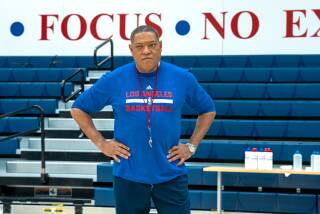Behind the story: How basketball stats bolstered math theory for one number-crunching reporter

- Share via
Ralph Lawler’s voice has been in the background of countless basketball games that I’ve watched over the years.
Over 40 seasons of calling the Clippers, he developed a number of trademark calls, but he hung his name on one: Lawler’s Law, his proposition that the first team to 100 points would win the game.
What I liked about Lawler’s Law was that it attempted to forecast the future in a simple way. I earned a degree in statistics — the art of using data to infer truths about the world — and this always struck me as a rudimentary kind of statistical model.
Of course it always was a bit of a gimmick, but it seemed to hold true more often than not.
That was just my intuition. So I collected the data.
As a journalist with The Times’ Data Desk, I’ve used data to tell stories about public policy, money in politics and elections, among many other topics.
Basketball has always been my top hobby, whether playing, watching, reading about or generally discussing the sport.
The numbers behind basketball games are a key reason why I have the skills I do today. My obsession with reading box scores in newspapers as a kid turned into a passion for data analysis. While in college, playing around with basketball statistics helped reinforce the mathematical theory and programming languages I was learning in classes.
It helps that sports data are freely available. You usually don’t have to file a California Public Records Act request or break through government bureaucracy to get most of the stats counted during games.
For this story, I used a tool I learned about on the NBA subreddit (where I spend more time than I care to admit) that let me write a script to gather the league’s official play-by-play data for every game going back to 1997. The play-by-play is a chronological record of most of the events that transpire in a game. It’s about 500 lines per game these days.
For each of the games, more than 27,000 in all, I asked the same questions: Who scored 100 first? And did that team win?
The analysis confirmed my hunch that Lawler’s Law had a high success rate: It was 93.8% accurate across all NBA games and 93.6% right in Clippers games. (Lawler made the decree only on Clippers broadcasts, but he never said it applied to those games alone.)
As it turned out, the data held another surprise.
Lawler told me he never intended the phrase to be a scientific tool, but after talking to him, some players and others around the sport, I started to see Lawler’s Law as more than just a quip. It may have started as an inside joke with Clippers fans, but the simple proposition portends greater truths about the game.
More to Read
Get our high school sports newsletter
Prep Rally is devoted to the SoCal high school sports experience, bringing you scores, stories and a behind-the-scenes look at what makes prep sports so popular.
You may occasionally receive promotional content from the Los Angeles Times.








